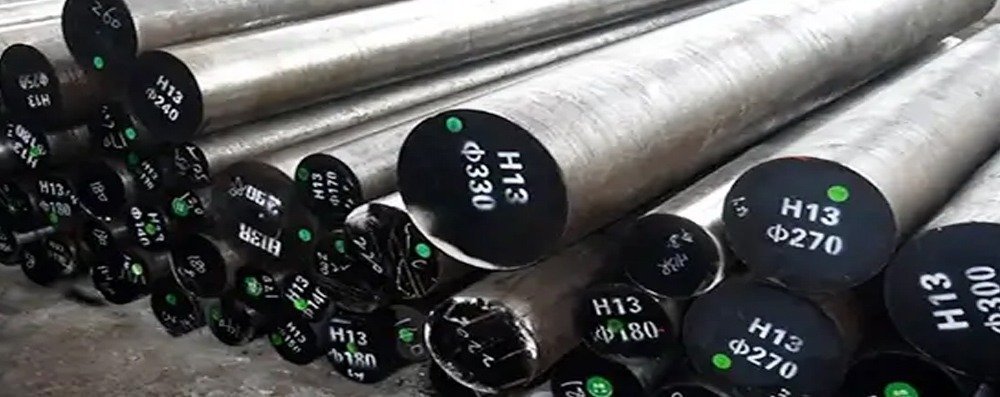Introduction
H13 tool steel is a chromium-molybdenum hot work steel widely known for its excellent combination of toughness, high hardenability, wear resistance, and resistance to thermal fatigue cracking. It retains strength and hardness at elevated temperatures, making it ideal for both hot work and cold work applications. H13 is often used in industries where high operating temperatures, sudden cooling cycles, and heavy mechanical stress are frequent.
Thanks to its outstanding thermal shock resistance and durability, H13 remains one of the most trusted and versatile tool steels worldwide, especially for critical tooling in die-casting, extrusion, and forging industries.
Properties of H13 Grade
- Excellent Thermal Shock Resistance
- High Toughness and Ductility
- Good High-Temperature Strength
- Outstanding Wear Resistance
- Excellent Machinability Compared to Other Tool Steels
- Resistant to Premature Heat Checking and Cracking
- Good Dimensional Stability After Heat Treatment
- Superior Through-Hardening Properties
Uses/Applications:
H13 tool steel is utilized in a wide variety of demanding applications, such as:
Hot Work Applications:
- Die casting dies for aluminum, magnesium, and zinc
- Extrusion dies and tools
- Hot shear blades
- Hot punching and trimming dies
Cold Work Applications:
- Plastic injection molds
- Die inserts
Aerospace and Automotive Industries:
- Aircraft landing gears
- Components subjected to thermal cycling
General Engineering:
- Shafts, spindles, tooling requiring high wear and toughness
Heat Treatment:
Annealing:
- Heat to 843°C – 871°C.
- Hold at temperature for several hours.
- Cool slowly in furnace at a rate of about 10°C per hour to 538°C, then air cool.
- Resulting hardness: ≤ 229 HB.
Hardening:
- Preheat in two stages: 600°C – 650°C, then 850°C – 900°C.
- Austenitize at 1000°C – 1040°C.
- Quench in still air or in oil depending on component size.
Tempering:
- Immediately temper after quenching to avoid cracking.
- Recommended tempering range: 500°C – 650°C.
- Double tempering is strongly recommended for optimum mechanical properties.
- Aim for final hardness between 48 and 55 HRC.
Chemical Composition:
| Element | Content (%) |
| Carbon (C) | 0.32 – 0.45 |
| Manganese (Mn) | 0.20 – 0.50 |
| Silicon (Si) | 0.80 – 1.20 |
| Chromium (Cr) | 4.75 – 5.50 |
| Molybdenum (Mo) | 1.10 – 1.75 |
| Vanadium (V) | 0.80 – 1.20 |
| Phosphorus (P) | ≤ 0.03 |
| Sulfur (S) | ≤ 0.03 |
This composition provides the combination of hardness, toughness, and thermal resistance that defines H13.
Mechanical Properties:
| Property | Typical Value |
| Hardness (Annealed) | ≤ 229 HB |
| Hardness (After Hardening) | 48 – 55 HRC |
| Tensile Strength (Ultimate) | 1400 – 1550 MPa |
| Yield Strength (0.2% offset) | 1100 MPa (approx.) |
| Elongation at Break | 13–15% |
| Impact Toughness (Charpy) | High (>20 J at room temp.) |
Values may vary depending on heat treatment and specific manufacturing processes.
Physical Properties:
| Property | Typical Value |
| Density | 7.80 g/cm³ |
| Modulus of Elasticity | 215 GPa |
| Thermal Conductivity | 24.0 W/m·K at 20°C |
| Specific Heat Capacity | 460 J/kg·K |
| Coefficient of Thermal Expansion | 12.0 × 10⁻⁶ /°C (20–100°C) |
The balance between thermal conductivity and toughness enables H13’s excellent performance under thermal cycling.
Forging:
Forging Temperature Range: 1050°C to 1150°C.
Procedure:
- Preheat uniformly to 850°C – 900°C.
- Raise temperature gradually to forging range.
- Do not forge below 850°C to prevent micro-cracking.
- Cool slowly after forging, ideally in an insulating material or furnace.
Post-forging annealing is highly recommended to relieve stresses.
Dimensional Tolerances:
Bright Bars:
- Tolerances as per ASTM A681 / DIN standards.
- Generally precision-ground to h9/h11 tolerance classes.
Forged and Rolled Bars:
- Tolerances based on diameter, length, and straightness specifications.
Strict dimensional control is crucial for die applications.
Machinability:
Relative Machinability: 70–75% (based on 1% carbon steel as 100%).
Machining Tips:
- Machine in annealed condition whenever possible.
- Use high-speed steel or carbide cutting tools.
- Reduce machining speeds if material is hardened.
Pre-heating before heavy machining operations is advised to reduce cracking risks.
Corrosion Resistance:
- H13 does not possess inherent corrosion resistance.
- Subject to rusting if exposed to moisture or corrosive environments without protection.
- Can be nitrided or surface coated (e.g., PVD coatings) to enhance corrosion and wear resistance.
Proper storage and maintenance are important to prevent rust.
Weldability:
- Moderate weldability with care.
- Preheating to 300°C–400°C is essential before welding.
- Post-weld heat treatment (stress relieving) is necessary to restore toughness and prevent cracking.
- Use suitable filler material for compatibility (e.g., H13 welding rods).
Welding should only be done by experienced professionals.
Available Form:
H13 tool steel is available in a wide variety of forms:
- Bright Round Bars
- Forged Bars
- Flat Bars
- Blocks
- Plates
- Custom Sizes upon request
Suppliers can offer different sizes based on project specifications.
Conclusion:
H13 tool steel stands out as an industry standard for hot work applications due to its superior toughness, excellent thermal fatigue resistance, and high wear resistance at elevated temperatures. Its ability to maintain hardness and strength after repeated thermal cycling makes it essential for die-casting dies, extrusion tools, forging dies, and plastic molds. Proper heat treatment and surface conditioning can significantly enhance its performance, extending service life even in the most demanding conditions. With proper handling, H13 delivers outstanding reliability, making it a top choice across aerospace, automotive, and heavy engineering industries.
Related Products : D2, DB6, DIN 1.2714, DIN 1.2080, DIN 1.2379, DIN 1.2343, DIN 1.2344, EN31, H11, H13, OHNS, HCHCR, M2, P20+S, P20, P20+Ni, K310, Maps


